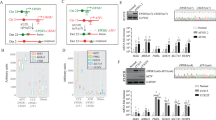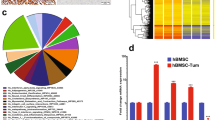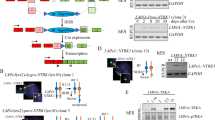Abstract
The neoplastic process may involve a cancer stem cell. This concept has emerged largely from the careful analysis of tumour biopsy systems from haematological, breast and brain tumours. However, the experimental systems necessary to provide the cellular and molecular evidence to support this important concept have been lacking. We have used adult mesenchymal stem cells (hMSC) transduced with the telomerase hTERT gene to investigate the neoplastic potential of adult stem cells. The hTERT-transduced line, hMSC-TERT20 at population doubling level (PDL) 256 showed loss of contact inhibition, anchorage independence and formed tumours in 10/10 mice. hMSC-TERT4 showed loss of contact inhibition at PDL 95, but did not exhibit anchorage independence and did not form tumours in mice. Both lines had a normal karyotype but showed deletion of the Ink4a/ARF locus. At later passage, hMSC-TERT4 also acquired an activating mutation in KRAS. In hMSC-TERT20, expression of the cell cycle-associated gene, DBCCR1 was lost due to promoter hypermethylation. This epigenetic event correlated with acquisition of tumorigenicity. These data suggest that the adult hMSCs can be targets for neoplastic transformation and have implications for the development of novel anticancer therapeutics and for the use of hMSC in tissue engineering and transplantation protocols.
This is a preview of subscription content, access via your institution
Access options
Subscribe to this journal
Receive 50 print issues and online access
$259.00 per year
only $5.18 per issue
Buy this article
- Purchase on Springer Link
- Instant access to full article PDF
Prices may be subject to local taxes which are calculated during checkout

Similar content being viewed by others
References
Al-Hajj M, Wicha MS, Benito-Hernandez A, Morrison SJ and Clarke MF . (2003). Proc. Natl. Acad. Sci. USA, 100, 3983–3988.
Collas P and Hakelien AM . (2003). Trends Biotechnol., 21, 354–361.
Dick JE . (2003). Proc. Natl. Acad. Sci. USA, 100, 3547–3549.
Gronbaek K, de Nully Brown P, Moller MB, Nedergaard T, Ralfkiaer E, Moller P, Zeuthen J and Guldberg P . (2000). Leukemia, 14, 1727–1735.
Hahn WC and Meyerson M . (2001). Ann Med., 33, 123–129.
Hahn WC and Weinberg RA . (2002). N. Engl. J. Med., 347, 1593–1603.
Hamad NM, Banik SS and Counter CM . (2002). Oncogene, 21, 7121–7125.
Helman LJ and Meltzer P . (2003). Nat. Rev. Cancer, 3, 685–694.
Hemmati HD, Nakano I, Lazareff JA, Masterman-Smith M, Geschwind DH, Bronner-Fraser M and Kornblum HI . (2003). Proc. Natl. Acad. Sci. USA, 100, 15178–15183.
Jiang Y, Jahagirdar BN, Reinhardt RL, Schwartz RE, Keene CD, Ortiz-Gonzalez XR, Reyes M, Lenvik T, Lund T, Blackstad M, Du J, Aldrich S, Lisberg A, Low WC, Largaespada DA and Verfaillie CM . (2002). Nature, 418, 41–49.
Kiyono T, Foster SA, Koop JI, McDougall JK, Galloway DA and Klingelhutz AJ . (1998). Nature, 396, 84–88.
Korbling M and Estrov Z . (2003). N. Engl. J. Med., 349, 570–582.
Lessard J and Sauvageau G . (2003). Nature, 423, 255–260.
Lundberg AS, Randell SH, Stewart SA, Elenbaas B, Hartwell KA, Brooks MW, Fleming MD, Olsen JC, Miller SW, Weinberg RA and Hahn WC . (2002). Oncogene, 21, 4577–4586.
Mackall CL, Meltzer PS and Helman LJ . (2002). Cancer Cell, 2, 175–178.
Milyavsky M, Shats I, Erez N, Tang X, Senderovich S, Meerson A, Tabach Y, Goldfinger N, Ginsberg D, Harris CC and Rotter V . (2003). Cancer Res., 63, 7147–7157.
Nishiyama H, Gill JH, Pitt E, Kennedy W and Knowles MA . (2001). Oncogene, 20, 2956–2964.
Owens DM and Watt FM . (2003). Nat. Rev. Cancer, 3, 444–451.
Park IK, Qian D, Kiel M, Becker MW, Pihalja M, Weissman IL, Morrison SJ and Clarke MF . (2003). Nature, 423, 302–305.
Passegue E, Jamieson CH, Ailles LE and Weissman IL . (2003). Proc. Natl. Acad. Sci. USA, 100 (Suppl 1), 11842–11849.
Perez-Losada J and Balmain A . (2003). Nat. Rev. Cancer, 3, 434–443.
Preston SL, Alison MR, Forbes SJ, Direkze NC, Poulsom R and Wright NA . (2003). Mol. Pathol., 56, 86–96.
Reya T, Morrison SJ, Clarke MF and Weissman IL . (2001). Nature, 414, 105–111.
Shi S, Gronthos S, Chen S, Reddi A, Counter CM, Robey PG and Wang CY . (2002). Nat. Biotechnol., 20, 587–591.
Simonsen JL, Rosada C, Serakinci N, Justesen J, Stenderup K, Rattan SI, Jensen TG and Kassem M . (2002). Nat. Biotechnol., 20, 592–596.
Singh SK, Clarke ID, Terasaki M, Bonn VE, Hawkins C, Squire J and Dirks PB . (2003). Cancer Res., 63, 5821–5828.
Wang J, Hannon GJ and Beach DH . (2000). Nature, 405, 755–756.
Acknowledgements
We thank Drs Steen Kølvraa, Charlotte B Sørensen and Thomas J Corydon for critical readings of the manuscript. This study was supported by grants from Danish Medical Research Council, Danish Center for Stem Cell Research, the Novo Nordisk foundation and Danish Cancer Society.
Author information
Authors and Affiliations
Corresponding author
Rights and permissions
About this article
Cite this article
Serakinci, N., Guldberg, P., Burns, J. et al. Adult human mesenchymal stem cell as a target for neoplastic transformation. Oncogene 23, 5095–5098 (2004). https://doi.org/10.1038/sj.onc.1207651
Received:
Revised:
Accepted:
Published:
Issue Date:
DOI: https://doi.org/10.1038/sj.onc.1207651
Keywords
This article is cited by
-
MicroRNA-3148 acts as molecular switch promoting malignant transformation and adipocytic differentiation of immortalized human bone marrow stromal cells via direct targeting of the SMAD2/TGFβ pathway
Cell Death Discovery (2020)
-
A prospect of cell immortalization combined with matrix microenvironmental optimization strategy for tissue engineering and regeneration
Cell & Bioscience (2019)
-
Neoplastic Transformation of Human Mesenchymal Stromal Cells Mediated via LIN28B
Scientific Reports (2019)
-
Current status and potential challenges of mesenchymal stem cell-based therapy for malignant gliomas
Stem Cell Research & Therapy (2018)
-
A novel method for banking stem cells from human exfoliated deciduous teeth: lentiviral TERT immortalization and phenotypical analysis
Stem Cell Research & Therapy (2016)



